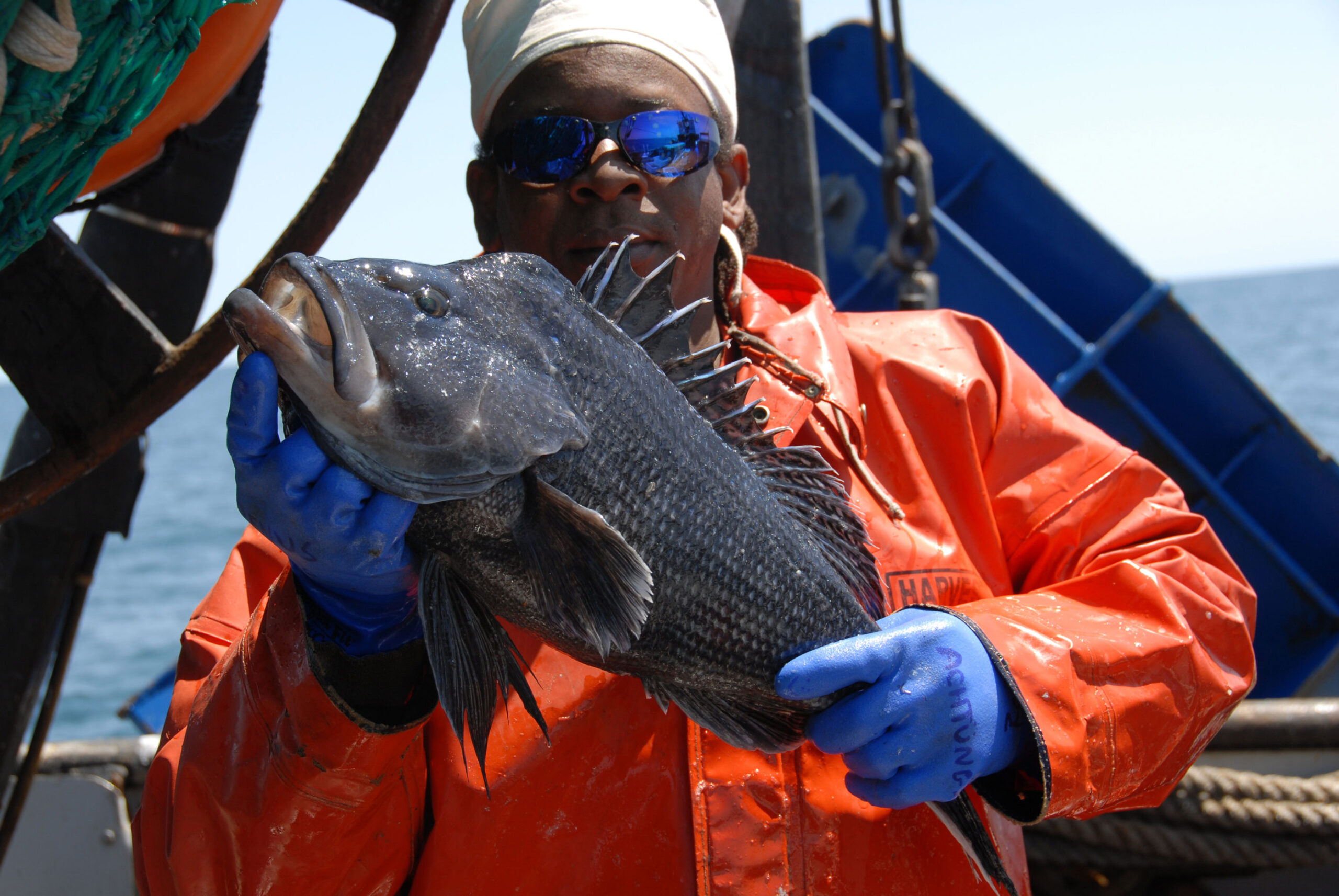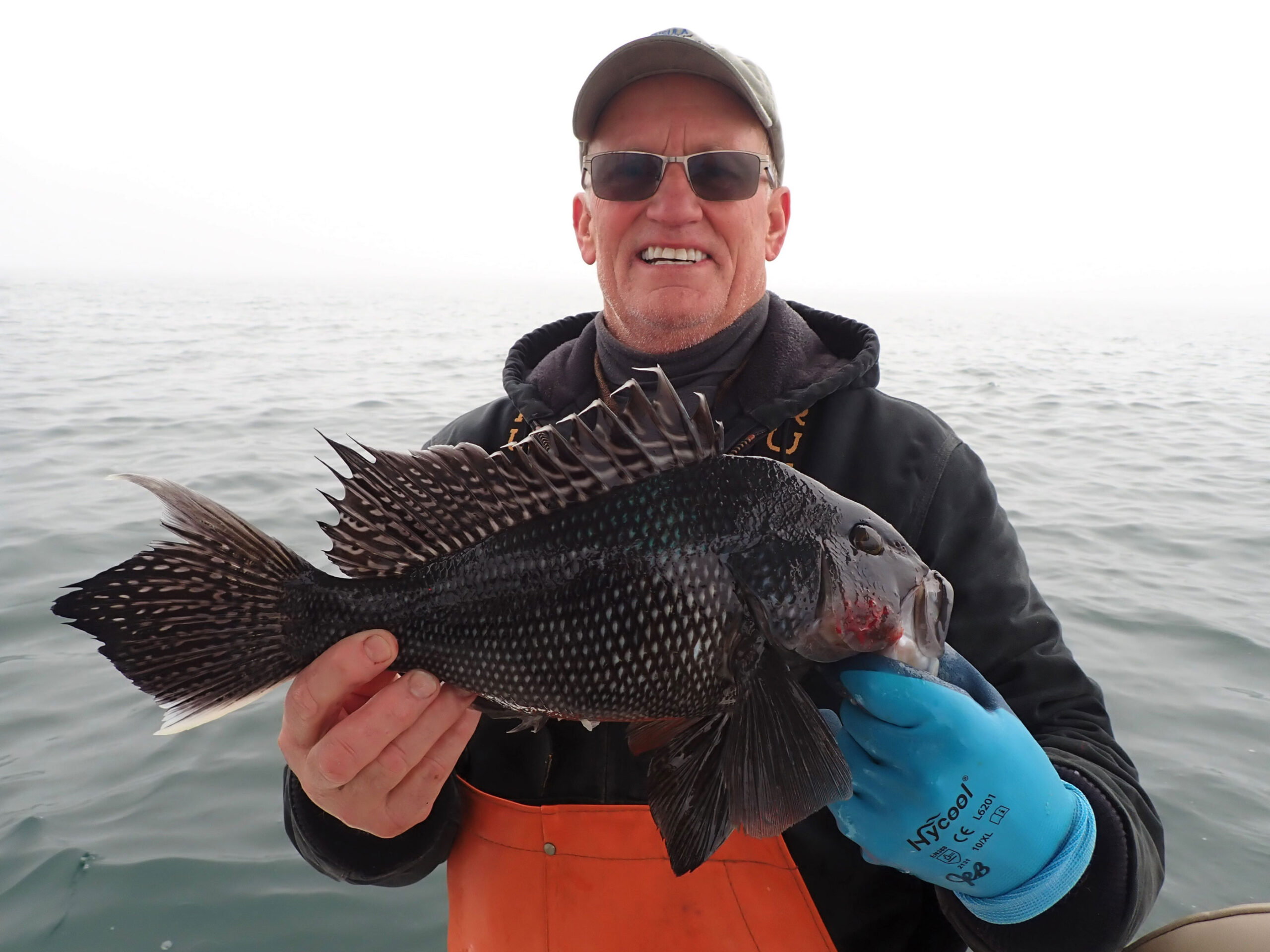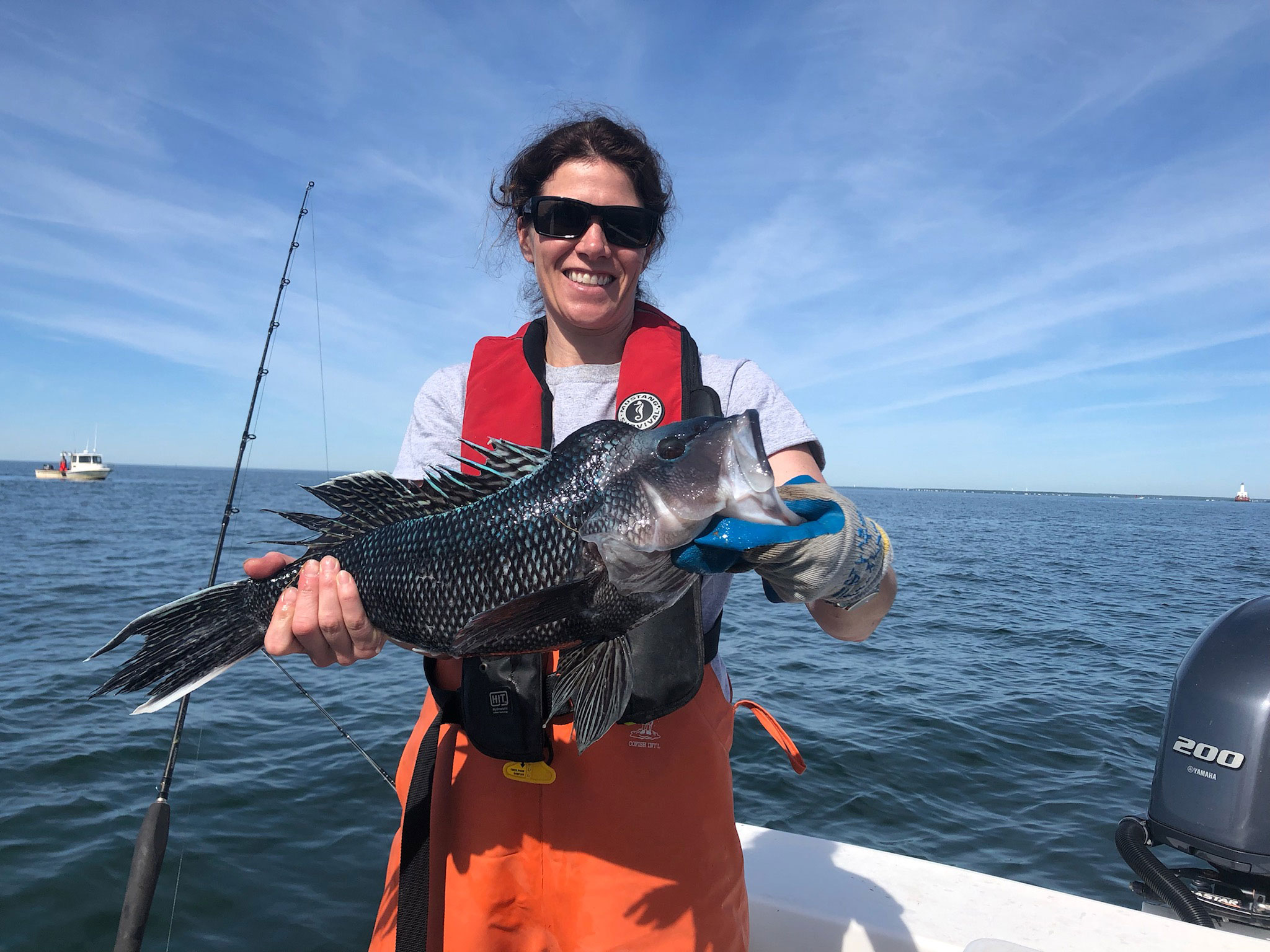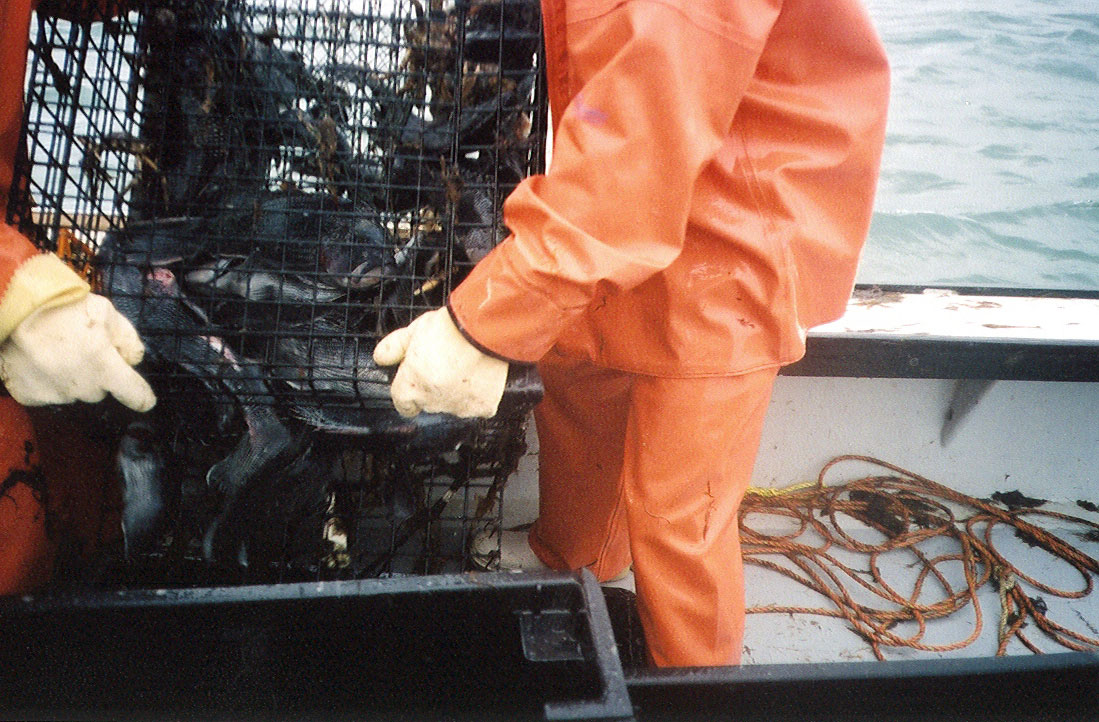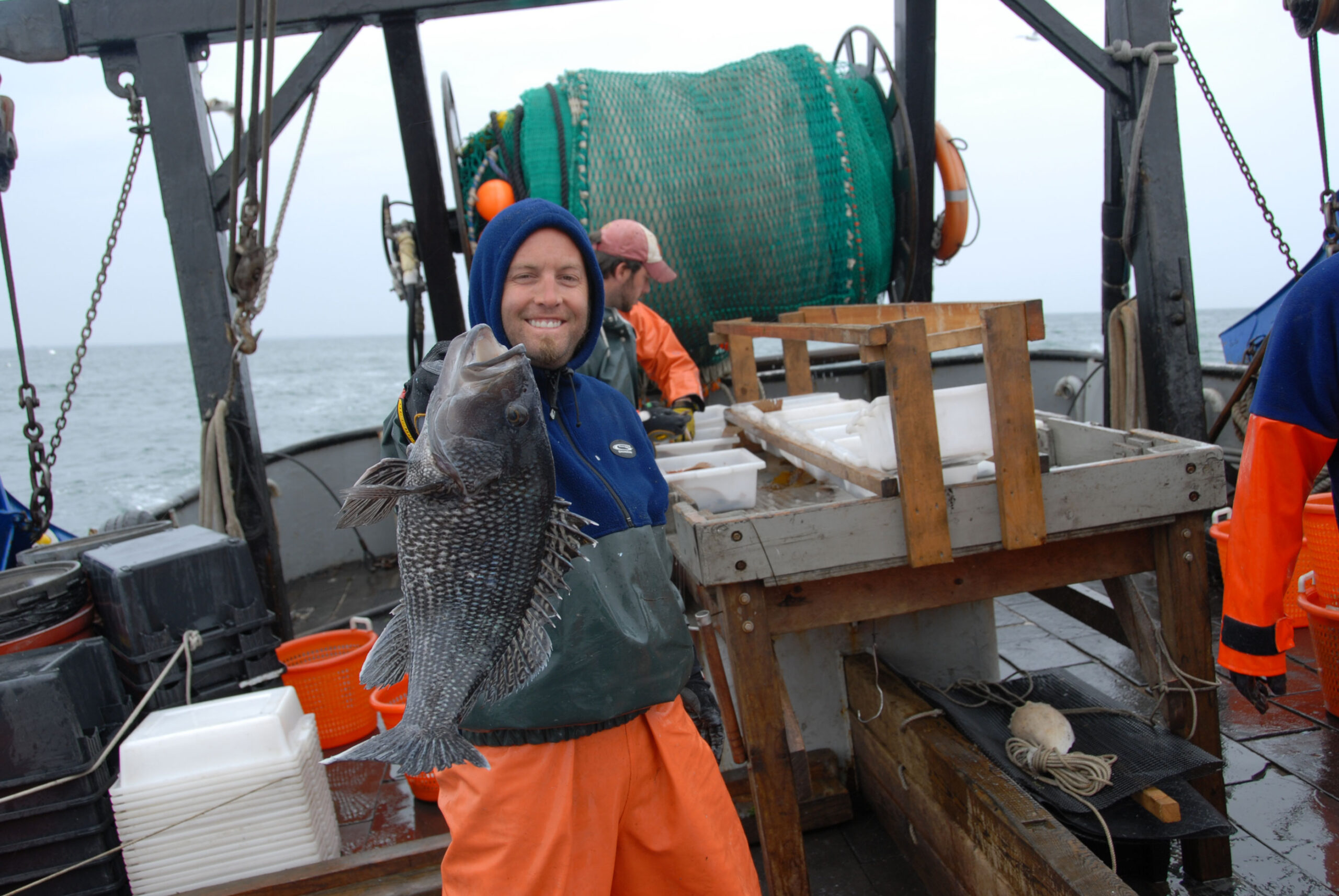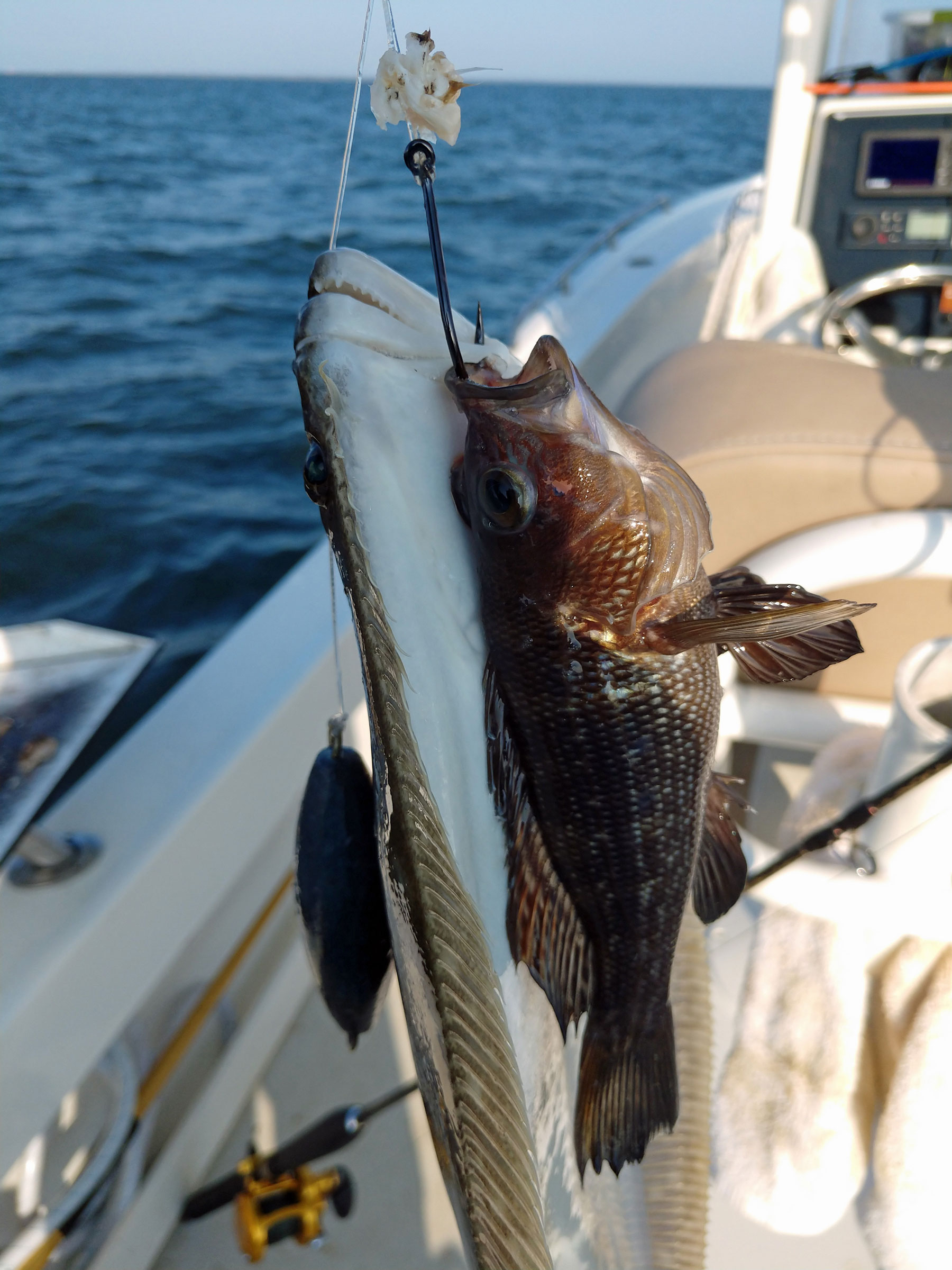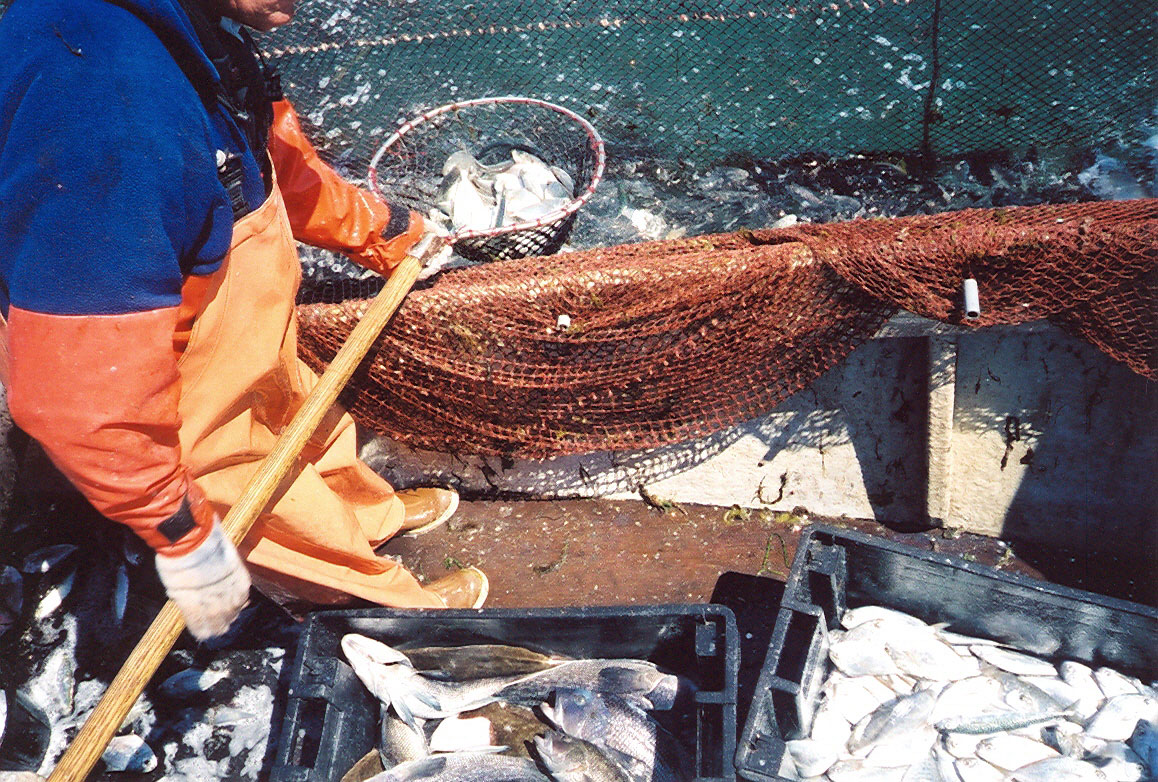Black Sea Bass

-
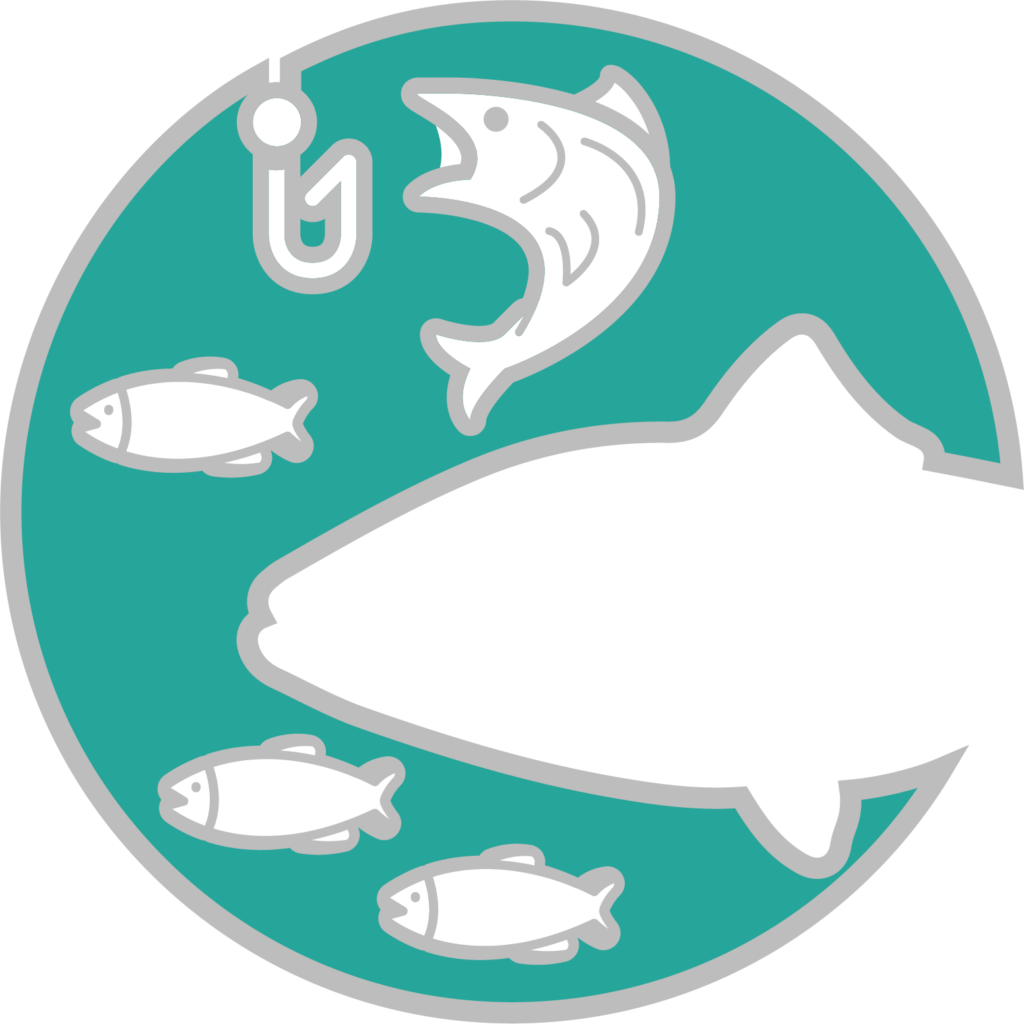
Population Abundance
Not overfished

Fishing Mortality
Overfishing not occurring
Current Status
Stock status based on 2025 management track stock assessment. Spawning stock biomass estimated to be 2.8 times the biomass target.
Meeting Calendar
Next Meeting
-
Dec 15–18, 2025
MidAtlantic Fishery Management Council
The Madison Hotel, 1177 15th Street NW, Washington, DC 20005
-
Recent Management Actions
Contacts
- Tracey Bauer, FMP Coordinator (TBauer@asmfc.org)
- Management Board, John Maniscalco, Chair
- Technical Committee, Rachel Sysak, Chair
- Summer Flounder, Scup and Black Sea Bass Advisory Panel
Species Information
Black sea bass are prized reef fish found along the Atlantic coast from the Gulf of Maine to Florida, renowned for their vibrant appearance and importance to both commercial and recreational fisheries. Managed under the Interstate Fishery Management Plan, black sea bass fisheries employ quota systems, size and bag limits, and seasonal closures to ensure sustainable harvesting and protect spawning populations. Recent assessments show healthy populations north of Cape Hatteras, while adaptive management measures continue to support the species’ resilience and long-term sustainability.
Management
Black sea bass is managed jointly by the Atlantic States Marine Fisheries Commission and the Mid-Atlantic Fishery Management Council (Council) under Amendment 13 to the Summer Flounder, Scup and Black Sea Bass Fishery Management Plan (FMP; August 2002) and its subsequent addenda (Addenda XII-XXXVI). The objectives of the FMP are to reduce fishing mortality to assure overfishing does not occur, reduce fishing mortality on immature black sea bass to increase spawning stock biomass, improve yield from the fishery, promote compatible regulations among states and between federal and state jurisdictions, promote uniform and effective enforcement, and minimize regulations necessary to achieve the stated objectives.
The recreational fishery is currently managed on a regional basis using a combination of minimum size limits, bag limits and fishing seasons to achieve a harvest target determined by the Percent Change Approach, as described in Addendum XXXIV. The coastwide commercial quota is divided among the states annually. Specific management measures for the commercial fishery are set by each state, which may include 1) minimum size limits, 2) minimum mesh requirements for trawls or 3) a moratorium on entry into the fishery and closed seasons.
In December 2018, the Board approved Addenda XXXI and XXXII to the FMP. Addendum XXXI adds to the suite of tools available for management, with particular focus on enhancing the compatibility of state and federal regulations, by allowing the use of conservation equivalency for recreational management starting in 2020. Conservation equivalency allows recreational management measures in federal waters measures to be waived, and instead requires recreational anglers to abide by the measures of the state in which they land their catch. The Board and Council will annually decide whether to enact conservation equivalency.
Addendum XXXII establishes an annual specifications process for developing recreational management measures. The Board will approve regional measures in early spring each year, based on technical committee analysis of stock status, resource availability, and harvest estimates. Public input on specifications will be gathered by states through their individual public comment processes. The specifications process will provide the Board more flexibility in adjusting measures, if necessary, to constrain harvest to the annual coastwide recreational harvest limit (RHL). Further, the process will enable the Board to consider a host of factors, including: regional equity; regulatory stability; species abundance and distribution; and late-breaking recreational harvest estimates.
In June 2021, the Board and the Council jointly approved final changes to the management program for black sea bass commercial fisheries. These changes include modifying the state allocations of the commercial black sea bass quota, adding the state allocations to the Council’s FMP, and modifying the regulations for federal in-season closures. The Board adopted the new allocations through Addendum XXXIII to the Summer Flounder, Scup and Black Sea Bass FMP, while the Council recommended to NOAA Fisheries these changes through Amendment 23 to its FMP. These actions address significant changes in the distribution of black sea bass that have occurred since the original allocations were implemented under Amendment 13 in 2003 and also account for the historical dependence of the states on the black sea bass fishery. In August 2023, NOAA Fisheries partially approved Amendment 23, by approving changes to the commercial in-season quota trigger, but disapproved adding the state-by-state quota allocations to the Federal FMP. However, the state-by-state quota allocations for black sea bass remain in effect through the Commission’s Addendum XXXIII.
In December 2021, the Board and the Council took final action on a joint amendment to reevaluate the FMP’s commercial and recreational allocations. This action aimed to address the allocation-related impacts of the revised recreational catch and landings data provided by MRIP. The changes were effective January 1, 2023.
In June 2022, the Commission’s Interstate Fisheries Management Program Policy Board (Policy Board) and the Council approved a new process for setting recreational measures (bag, size, and season limits), referred to as the Percent Change Approach, as well as modifications to the recreational accountability measures for summer flounder, scup, black sea bass, and bluefish. The Policy Board adopted these changes through Addendum XXXIV to the Summer Flounder, Scup, and Black Sea Bass FMP and Addendum II to the Bluefish FMP. The Council and Policy Board also agreed to continue to work on developing an improved approach to setting recreational measures for summer flounder, scup, black sea bass, and bluefish. The Percent Change Approach was implemented in 2023, and will sunset at the end of 2025.
In April 2025, the Policy Board and Council adopted Addendum XXXVI to the Summer Flounder, Scup, and Black Sea Bass FMP and Addendum III to the Bluefish FMP, which made further modifications to the process for setting recreational measures and accountability measures for these four species. The changes, which include modifications the Percent Change Approach based on lessons learned over the past few years, will be implemented in two phases.
The first phase of changes aims to better account for stock status when setting measures and will create more opportunities for stability in management measures. The current system uses three biomass categories to guide whether measures should change; the revised approach adds a fourth category for stocks near their biomass target and establishes a separate process for overfished stocks. These changes will take effect starting with the 2026 recreational measures for summer flounder, scup, and black sea bass. The Council and Policy Board delayed the implementation of these changes for bluefish until 2028 to allow time for development of an appropriate methodology for evaluating the impacts of measures on bluefish harvest and discards. The bluefish stock has been under a rebuilding plan since 2022, and recreational measures will continue to be set based on the rebuilding plan until the stock is declared rebuilt.
The second phase of modifications, which will be implemented for setting 2030 recreational measures and beyond, will update the process to use a catch-based target. Unlike the current process – which focuses on achieving a specific level of predicted harvest – a catch-based approach aims to achieve a target level of total dead catch, including both harvest and dead discards. This approach will allow for more explicit consideration of how measures affect discards. The Council and Policy Board delayed the transition to a catch-based target until 2030 to allow time for additional analysis on the potential impacts to measures.
The specifications for the 2025 fishing season are status quo from 2024, including a 6-million-pound commercial quota and a 6.27-million-pound RHL. In August 2025, the Board approved specifications for the 2026-2027 season, including a 7.83-million-pound commercial quota and an 8.14-million-pound RHL.
Stock Status
A management track assessment was peer reviewed in July 2025. The assessment updated a Woods Hole Assessment Model (WHAM) framework developed during the recent 2023 research track assessment with fishery-independent and -dependent data through 2024. The assessment found that the black sea bass stock north of Cape Hatteras, North Carolina was not overfished and overfishing was not occurring in 2024.
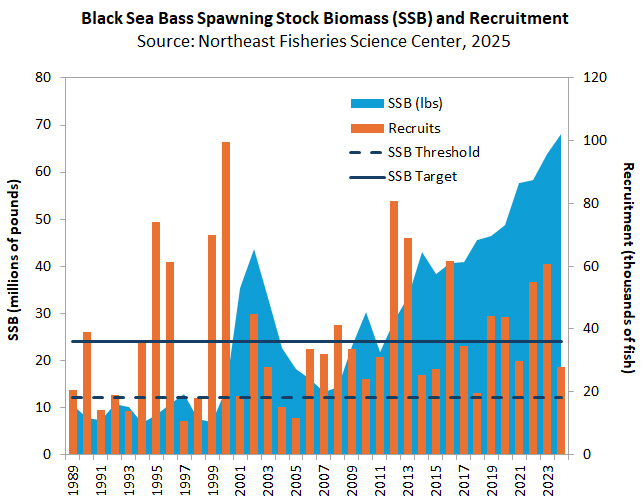
In 2024, spawning stock biomass (SSB) was estimated at 68.1 million pounds, 2.84 times the biomass target of 24.0 million lbs. The fully selected fishing mortality in 2024 was estimated to be 0.75, 73% of the of the overfishing threshold proxy of 1.03.
Recruitment in 2024 was estimated to be 27.8 million fish, below the 10-year (2015-2024) average of 40.4 million fish.
Commercial & Recreational Fisheries
Black sea bass are highly sought by both commercial and recreational fishermen throughout the Mid-Atlantic. Fisheries change seasonally with changes in fish distribution. Inshore and more southern commercial fisheries primarily use fish pots and handlines, and when fish move offshore in the winter, they are primarily caught in trawl fisheries targeting summer flounder, scup, and Loligo squid. Recreational fisheries generally occur during the period that sea bass are inshore (May to September), but season duration varies among the states. Since the fishery management plan’s approval in 1997, the black sea bass commercial fishery has operated under a quota.

Commercial landings have been recorded since the late 1800s. Fish were primarily harvested by handlines until the early 1950s. From 1887 through 1948, commercial landings north of Cape Hatteras fluctuated around six million pounds. By 1952, with the emergence of the trap fishery, landings peaked at 22 million pounds. Since 1998, commercial landings have been primarily influenced by the commercial quotas. Between 1998 and 2007, landings averaged 2.8 million pounds. From 2008 to 2012, reduced quotas resulted in average landings of only 1.6 million pounds. From 2017-2024, higher quotas resulted in commercial landings of ranging between 3.34 million pounds in 2018 to a time series high of 5.1 million pounds in 2022. Commercial landings declined in 2023 to 4.6 million pounds, just under the coastwide quota of 4.8 million pounds. Commercial fishery discards historically represented a small fraction of total fishery removals from the stock at less than 0.4 million pounds per year, but have increased in recent years. In 2024, commercial dead discards were 2.68 million pounds. Otter trawls and fish pots/traps have accounted for the majority of the black sea bass landings in most states. Other important gears include handlines and lobster pots.
Black sea bass are also an important recreational species in the Mid-Atlantic, commonly caught using squid and natural bait. In 1965, over half of the total catch of black sea bass was credited to recreational fishing. In 2018, recreational harvest estimates from the Marine Recreational Information Program (MRIP) were recalibrated based on the new Fishing Effort Survey (FES). In general, the recalibration resulted in higher harvest estimates throughout the time series, with more divergence in recent years. After a peak in 1986 at 11.19 million pounds, recreational harvest averaged 5.02 million pounds annually from 1987 to 1997. Recreational harvest limits were put in place in 1998 and harvest generally increased from 1.92 million pounds in 1998 to 9.06 million pounds in 2015. In 2016 and 2017 harvest jumped up to 12.05 and 11.48 million pounds, respectively; however, the 2016 and 2017 estimates are regarded as implausibly high outliers by the Technical Committee. Recreational harvest for black sea bass from Maine to Cape Hatteras peaked again in 2021 at 11.97 million pounds (6.44 million fish), then declined in 2022 through 2024, to 5.4 million pounds, which is the lowest recreational harvest since 2011. Recreational live discards as a proportion of total catch have generally increased over the time series, averaging 46% in the 1980s, and 86% over the last decade. According to MRIP, total live recreational discards from Maine to Virginia were 35.6 million fish in 2024. Assuming 15% hook and release mortality, estimated recreational discard losses in 2024 were estimated to be 4.8 million fish, equal to 61% of the total recreational removals (harvest plus dead discards).
Life History
Black sea bass (Centropristis striata) inhabit Atlantic coastal waters from the Gulf of Maine to the Florida Keys, concentrating in areas from Cape Cod, Massachusetts to Cape Canaveral, Florida. A temperate reef fish, black sea bass commonly inhabit rock bottoms near pilings, wrecks, and jetties. Black sea bass rely on their large mouth and swift ocean currents to catch prey, which include fish, crabs, mussels, and razor clams. Two distinct stocks of black sea bass exist along the Atlantic coast with overlapping ranges. The northern stock migrates seasonally. Black sea bass summer in northern inshore waters at depths of less than 120 feet and winter in southern offshore waters at depths of 240 to 540 feet. Spawning occurs off of New England in the late summer.
Black sea bass are protogynous hermaphrodites, which mean they start life as a female and then change sex to become males when they reach 9-13 inches (2 – 5 years of age). Thirty-eight percent of females in the Mid-Atlantic demonstrate sex reversal between August and April, after most fish have spawned. Even though some fish are males when they reach sexual maturity, most produce eggs when they first mature. Following transition, a sea bass will either become a dominant male, characterized by a larger size and a bright blue nuchal hump during spawning season, or a subordinate male that has few distinguishing features.
News & Resources
Explore recent news, management updates, and scientific reports to gain a deeper understanding of ongoing conservation efforts and sustainability strategies.
-
Recreational Measures Setting Process for Summer Flounder, Scup, Black Sea Bass, and Bluefish
-
The Mid-Atlantic Fishery Management Council met August 12-14, 2023, in Annapolis, MD. As part of the meeting the Atlantic States Marine Fisheries Commission’s (Commission) Interstate Fisheries Management Program Policy Board (Policy Board), Bluefish Management Board (Board), and Summer Flounder, Scup and Black Sea Bass Management Board (Board), met jointly with the Council to take action…
-
Prepared for the Commissioner Manual
-
This assessment of the Black Sea Bass (Centropristis striata) stock is a Level-2 2024 management track assessment which updates the 2023 research track assessment model using the WHAM framework to fit a spatially explicit model specified for two regions, North or South of Hudson Canyon.
-
-
The MAFMC and ASMFC Interstate Fisheries Management Program Policy Board (Policy Board) have approved modifications to the process for setting recreational measures (bag, size, and season limits), as well as the recreational accountability measures, for summer flounder, scup, black sea bass, and bluefish. The MAFMC recommended these changes through a framework action, and the Policy…
-
The Mid-Atlantic Fishery Management Council’s (Council’s) Summer Flounder, Scup, and Black Sea Bass and Bluefish Advisory Panels (APs) met jointly with the Atlantic States Marine Fisheries Commission’s (Commission’s) Summer Flounder, Scup, and Black Sea Bass and Bluefish APs on March 13, 2025 to review public comment, review a summary of the recent Fishery Management Action…
-
-
-
This press release revises the February 3rd announcement by changing the date of the New Jersey hearing from February 24 to February 25. The hearing time and location remain the same.
-
-
The purpose of this proposed amendment is to consider modifications to the recreational management program for summer flounder, scup, black sea bass, and bluefish. Specifically, the amendment may consider options for managing for-hire recreational fisheries separately from other recreational fishing modes (referred to as sector separation), as well as options related to the collection and…
-
Arlington, VA – The Atlantic States Marine Fisheries Commission releases for public comment the Public Information/Scoping Document for the Recreational Sector Separation and Data Collection Amendment for Summer Flounder, Scup, Black Sea Bass and Bluefish. The document is a joint effort of the Commission and the Mid-Atlantic Fishery Management Council given the species are managed…
-
-
DRAFT SCOPING AND PUBLIC INFORMATION DOCUMENT
Get Hooked on ASMFC News
Dive into the latest updates and catch all the important news by joining our newsletter mailing list. Stay in the loop with meeting agendas, fisheries management news, and more.
